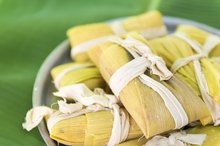Before Spanish explorers arrived in Mexico in the 1500s, tamales were already a staple in the ancient Aztec diet. Consisting of corn dough wrapped around a filling, then steamed in a corn husk wrapper, tamales can contain fruit, beans, cheese, fish, poultry or meat. Pork tamales are a popular option for home cooks or as a refrigerated, restaurant or frozen entree. Enjoy pork tamales in moderation: Most are high in saturated fat and sodium.
Tips
Pork Tamales has 177 Calories and 7.96 g of Protein per 100 gram serving according to the nutrition facts provided by the USDA Food Composition Database.
Calories in Restaurant Tamales
A typical restaurant-style pork tamale without added sauce contains around 250 calories. Of this number, 90 calories or approximately 36 percent of the dish's total caloric content, are supplied by the tamale's 10 grams of total fat, 4 grams of which come from saturated fat. A restaurant pork tamale gets 48 percent of its calories, or 120 calories, from 30 grams of carbohydrates. Protein supplies 40 calories per pork tamale, which is 16 percent of the total number of calories.
- A typical restaurant-style pork tamale without added sauce contains around 250 calories.
- A restaurant pork tamale gets 48 percent of its calories, or 120 calories, from 30 grams of carbohydrates.
Calories in Frozen Tamales
Can I Eat Prosciutto Ham Without Cooking It?
Learn More
A 5-ounce commercially available frozen pork tamale contains 270 total calories. The manufacturers say that frozen pork tamales get 120 of these calories from 13 grams of fat, including 4.5 grams of saturated fat -- which means that 44 percent of the entree's calories are fat calories. Carbohydrates contribute around 34 percent of the calories in a frozen pork tamale, with 23 grams per serving, while the 14 grams of protein in each supplies approximately 56 calories, or nearly 21 percent of the overall total number of calories.
- A 5-ounce commercially available frozen pork tamale contains 270 total calories.
- The manufacturers say that frozen pork tamales get 120 of these calories from 13 grams of fat, including 4.5 grams of saturated fat -- which means that 44 percent of the entree's calories are fat calories.
Calories in Refrigerated Tamales
Brands of refrigerated pork tamales contain a similar calorie count to frozen or restaurant-style tamales, with 260 calories per serving. With 14 grams of fat, 5 grams of which are saturated fat, a refrigerated pork tamale contains approximately 120 calories from fat, according to the manufacturers. This number is 46 percent of the tamale's total number of calories. Carbohydrates account for about 40 percent of the calories in refrigerated pork tamales, and protein is responsible for 12 percent of the caloric content.
- Brands of refrigerated pork tamales contain a similar calorie count to frozen or restaurant-style tamales, with 260 calories per serving.
Calories in Homemade Tamales
The Calories in Calamari
Learn More
For a pork tamale with the fewest number of total calories per serving, try preparing your own at home. A homemade pork tamale made from a typical recipe contains 190 calories and 13 grams of fat. To get a leaner version, “Cooking Light” suggests that you use pork tenderloin instead of pork shoulder and only a small amount of vegetable oil to prepare the dough 5. Most pork tamales made at home are lower in carbohydrates than frozen, refrigerated or restaurant options. Typically, each contains 9 grams of carbohydrates, or almost 19 percent of the total calories. Protein supplies 18 percent of caloric content, with 9 grams per tamale.
- For a pork tamale with the fewest number of total calories per serving, try preparing your own at home.
Related Articles
References
- Gourmet Sleuth: Tamales
- Chevys: Nutritional Information
- Windsor Foods: Posada - Pork Tamale 5 Oz - 1/60 Ct Bulk
- Santfetamales.com: (Posa's) Tamales Nutritional Information
- Cooking Light: Christmas Eve Tamales
- My Recipes: Mama Totota's Tamales
- Pork, fresh, loin, tenderloin, separable lean only, cooked, roasted. FoodData Central. U.S. Department of Agriculture. Published April 1, 2019.
- Pork steak or cutlet, broiled or baked, lean only eaten. FoodData Central. U.S. Department of Agriculture. Published April 1, 2019.
- Pork, fresh, ground, cooked. FoodData Central. U.S. Department of Agriculture. Published April 1, 2019.
- Pork chop, broiled or baked, lean and fat eaten. FoodData Central. U.S. Department of Agriculture. Published April 1, 2019.
- Pork chop, broiled or baked, lean only eaten. FoodData Central. U.S. Department of Agriculture. Published April 4, 2019.
- Pork chop, breaded or floured, fried, lean and fat eaten. FoodData Central. U.S. Department of Agriculture. Published April 4, 2019.
- Pork sausage. FoodData Central. U.S. Department of Agriculture. Published April 4, 2019.
- Pork bacon, smoked or cured, cooked. FoodData Central. U.S. Department of Agriculture. Published April 4, 2019.
- Pulled pork. FoodData Central. U.S. Department of Agriculture. Published April 4, 2019.
- Spam, Classic Spam. FoodData Central. U.S. Department of Agriculture. Published April 4, 2019.
- Naseeb MA, Volpe SL. Protein and exercise in the prevention of sarcopenia and aging. Nutr Res. 2017;40:1-20. doi:10.1016/j.nutres.2017.01.001
- American College of Allergy, Asthma and Immunology. Meat allergy. Updated May 8, 2019.
- Turesky RJ. Mechanistic evidence for red meat and processed meat intake and cancer risk: A follow-up on the International Agency for Research on Cancer Evaluation of 2015. Chimia (Aarau). 2018;72(10):718-724. doi:10.2533/chimia.2018.718
- Djurković-Djaković O, Bobić B, Nikolić A, Klun I, Dupouy-Camet J. Pork as a source of human parasitic infection. Clin Microbiol Infect. 2013;19(7):586-94. doi:10.1111/1469-0691.12162
Writer Bio
Michelle Kerns writes for a variety of print and online publications and specializes in literature and science topics. She has served as a book columnist since 2008 and is a member of the National Book Critics Circle. Kerns studied English literature and neurology at UC Davis.









